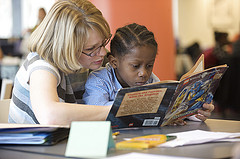Speech and Language Disorders

Photo credit: US Department of Education /CC BY 2.0
Speech and language disorders include the more easily-recognized stuttering to the more complex “apraxia.” Apraxia is a neurological disorder that causes an inability to talk due to the motor planning and coordination involved. Language disabilities can be expressive (what one says or writes) or receptive (what one hears). They include language-based learning disabilities, and selective mutism (wherein the child does not speak in specific situations).
Children who experience language-based learning disabilities may exhibit problems in finding a word and use fillers, like “um,” a lot. They have difficulty understanding and following written or spoken directions, and confuse left and right while reading and writing, or mix up the order of numbers and letters. Speech and language disabilities impact one’s academic, behavioral, and social relationships.
Recommendations
1. Consult with a speech/language therapist (also known as a speech/language pathologist, or SLP) who is able to evaluate children if you notice speech and/or language concerns such as the following:
- stuttering or lisping
- difficulty breathing or swallowing
- weak muscles around the mouth
- hoarseness
- difficulty understanding or processing language
- difficulty putting words together
- limited vocabulary
- an inability to use language in a socially-appropriate way
2. Be patient to allow your child the time required to produce the necessary sounds without becoming self-conscious or too discouraged to try.
3. Encourage dialogue at home, where children are most comfortable. Refrain from asking them to speak before strangers if they are not comfortable doing so.
4. Resource teachers in schools are best equipped to help children with language-based learning disorders. They can employ a variety of techniques, like the use of specific reading programs for children with reading disabilities such as dyslexia.
5. Model the process of verbalizing your thoughts. One example is to do a set of chores with your child and narrate your perspective on each step of the process. Use speech not only to describe what you are doing, but also the associated feelings. This gives children who may have difficulty expressing themselves a vocabulary for describing their feelings.
6. Encourage your child to sing. Singing allows children to learn new words and add some rhythm and cadence to their verbal expression. Singing may also help in pronouncing new words.
7. Teach (but do not pressure) your child to use speech in an appropriate fashion. For example, if your child makes a mistake in his/her verbal communication with you, do not force the child to correct it on the spot. Instead, correct it for them while responding. If, for example, your child states: “I go to school later,” you might respond by saying, “You are going to school later?” This will help the child learn the best way to express him/herself.
8. Children with mild speech and language difficulties are often overlooked by school systems and teachers. It may be helpful to consult with your child’s teacher as well as the speech and language specialist in your child’s school; this way you can determine whether an evaluation, or speech therapy is appropriate. Given the importance of speech-and-language issues for a child’s overall learning, it is very important to address this as early as possible.
Websites
Learning Works for Kids: The premier site for executive function information. It provides a wealth of up-to-date tips and recommendations for children with all types of disorders and disabilities.
American Speech-Language-Hearing Association: This site provides information regarding Childhood Apraxia of Speech, Orofacial Myofunctional Disorders, Speech Sound Disorders: Articulation and Phonological Processes, Stuttering, and more.
University of Michigan Health System: This gives parents tips on helping their child to develop language and to communicate in alternative ways.
American Speech-Language-Hearing Association: This site lists some activities to encourage speech and language development in children ages newborn to 6 years old.
Child Development Institute: This is a brief question-and-answer guide for parents of children with communication disorders.
Books
Dougherty, Dorothy P. (2005). Teach Me How to Say It Right: Helping Your Child with Articulation Problems. Oakland, CA: New Harbinger Publications.
Feit, Debbie. (2007). The Parents Guide to Speech and Language Problems. New York, NY: McGraw-Hill.
McAleer, Hamaguchi. (2001). Childhood Speech, Language, and Listening Problems: What Every Parent Should Know.New York, NY: Wiley.
Schetz, Katherine F. and Stuart Kent Cassell. (1994). Talking Together: A Parent’s Guide to the Development, Enrichment, and Problems of Speech and Language. Blacksburg, VA: Pocahontas Press.